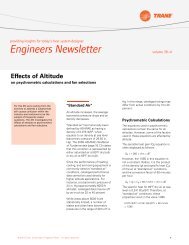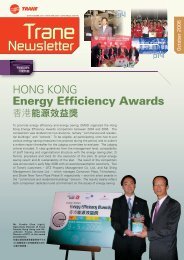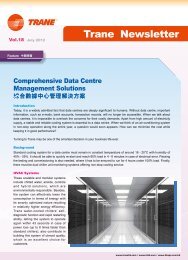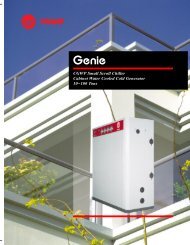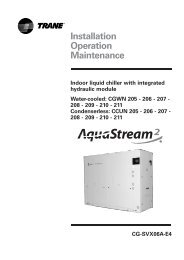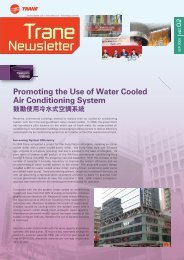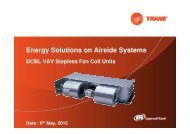Tracer SC (Catalogue)
Tracer SC (Catalogue)
Tracer SC (Catalogue)
Create successful ePaper yourself
Turn your PDF publications into a flip-book with our unique Google optimized e-Paper software.
Product Introduction<br />
From the home page, you can select:<br />
• All schedules, which shows all schedules in the system<br />
• Active schedules, which shows just the active schedules in the system<br />
Figure 4 shows an example of an All Schedules page.<br />
Figure 4.<br />
The All Schedules page<br />
Area<br />
Variable Air Systems<br />
Chilled Plant Control<br />
The Area application coordinates HVAC equipment for a specific area of the building. You can use<br />
the application to assign unit controllers, binary outputs, and binary values to be members of a<br />
common area. You can then efficiently perform a single operation (such as changing a setpoint,<br />
creating a schedule, performing an override) and apply it to all members of the area. In addition,<br />
the area application can use one of six algorithms, along with area temperatures and humidity<br />
inputs, to make an economizing decision. The application also supports optimal start/stop,<br />
humidity pulldown, night purge, unoccupied heating/cooling, unoccupied humidify, unoccupied<br />
dehumidify, and timed override functions.<br />
The Variable Air Systems (VAS) application coordinates air-handling units, variable-air-volume<br />
(VAV) boxes, and ventilation within a building. VAV units are assigned to the air-handling unit that<br />
supplies air to them. The VAS application coordinates the start-up and shut-down of the system to<br />
ensure proper static pressure control. Energy-saving applications, including static pressure<br />
optimization and ventilation optimization, are available as standard VAS application features.<br />
The Chiller Plant Control application coordinates chillers and provides system chilled water control.<br />
It controls the leaving-water temperature by adding chillers as the building cooling load increases,<br />
calculates the chilled water setpoint for each chiller, and recovers from failures by starting the next<br />
chiller in the sequence immediately after a chiller is marked as failed.<br />
8 BAS-PRC031-EN, 14 Jan 2011




